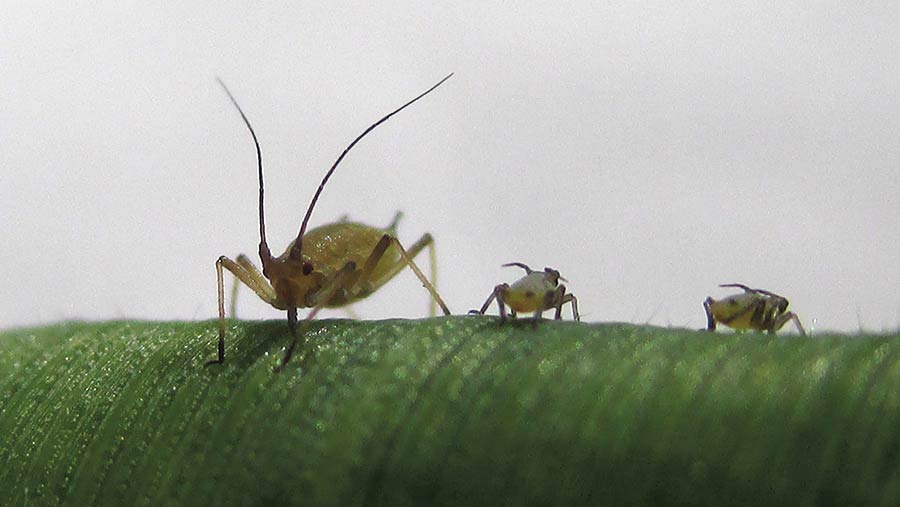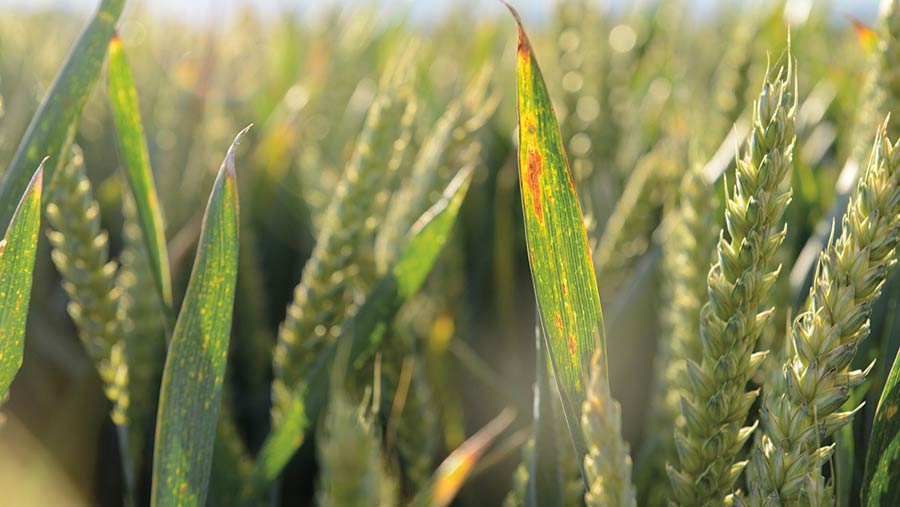Mild autumn increases virus threat to cereal crops
Cereal growers are being warned that a mild autumn could see an aphid-carried viral disease hit their crops. Experts advise the use of seed treatments and sprays to minimise damage to yields.
Last winter’s abnormally mild weather saw aphids flying until after Christmas, resulting in the most widespread level of barley yellow dwarf virus (BYDV) disease seen for more than 50 years.

Grain aphids
With one of the main aphid carriers of the disease showing high levels of resistance to widely used and inexpensive pyrethroid insecticides, growers face increased difficulties getting good control.
The major factor in the spread of BYDV is autumn temperatures, and bad infections in 2012 and 2016 followed very mild weather.
Alan Dewar, independent entomologist, says the worst BYDV cases in these high-infection years came in fields without an appropriate insecticide seed treatment.
“If we get a winter such as the last one, with aphids flying up to Christmas, there is the potential to get BYDV,” he says.
See also: Tips on avoiding last season’s cereal virus epidemic
Top tips for BYDV control
- Use seed treatments in high-risk disease situations
- Consider delaying sowing where BYDV is likely
- Break the green bridge between crops that can harbour aphids
- Monitor crops for the first signs of aphid activity
- Watch out for advice from Rothamsted and AHDB
Two key aphids
Activity from the two main BYDV vectors – the bird cherry-oat and grain aphids – is described as “normal” by Rothamsted Research’s Insect Survey when compared with the past 10 years.
The disease affects all cereals and shows up as bright yellow upper leaves scattered through the crop, and high infection levels are seen as one reason for disappointing grain yields this summer.
Mark Taylor, Rothamsted entomologist, says aphids usually stop flying in late October, and then November frosts will kill off many of them.
However, that didn’t happen last year, when they continued to fly into early January.
“It looks like a normal year so far for aphids, but if the warm weather persists, the aphid situation could get worse,” he says.
Experts advise using a seed treatment in high-risk BYDV situations and recommend using the neonicotinoid insecticide clothianidin (Deter), or together with fungicide prothioconazole (Redigo Deter).
Dr Dewar emphasises that most cereal crops with severe BYDV infections did not receive these seed treatments, which are generally believed to give protection for about six weeks.

Barley yellow dwarf virus in wheat
Top-up autumn spray
Problems can occur with early-sown crops that may need a top-up insecticide spray in the autumn. The only spray treatments available are pyrethroids, and grain aphids are showing resistance to these products.
Bird cherry-oat aphids are still susceptible to pyrethroids, but 50% of the grain aphid population are now resistant to these products.
“My belief is that the grain aphid is responsible for the BYDV outbreaks we have seen in the eastern counties,” says Dr Dewar.
The widespread use of pyrethroid has controlled bird cherry-oat aphids, but also kills predators such as wasps, leaving grain aphids to be the major problem.
Identification of aphids can be difficult in the field, as bird cherry-oat aphids feed very near to ground level, so the best advice is to monitor Rothamsted and AHDB advice and find out more from Rothamsted’s insect survey and the AHDB aphid monitoring website.
Insect survey
The Rothamsted insect survey has been running two networks of insect traps since 1964, providing details on numbers of aphids, moths and other insects.
Max Newbert, insecticide specialist at agrochemical group Syngenta, warns that warm weather increases the numbers and movements of aphids and can also shorten the persistency of any seed treatment.
He points out that lush, green stubbles designed to encourage blackgrass to chit can help aphids survive until new autumn crops emerge and so exacerbate the disease risk.
Fast knock-down of aphids is important to stop feeding and virus spread, and he recommends the group’s pyrethroid product lambda-cyhalothrin (Hallmark).

